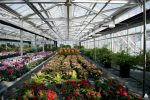Natural ventilation in humid regions.
Ventilation of greenhouses in humid tropical areas presents the grower with a complete new set of problems. There are various methods available but none have the desired effect. Screening is limited since it can only be applied during certain periods of the day and it limits the amount of sunlight reaching the plants. Evaporative pads do not work properly in humid areas because of the high RH outside and inside the greenhouse. Using refrigeration systems are to expensive and forced ventilation systems also have limited effect with high running cost. The only effective method is natural ventilation. So the greenhouse must be designed to make full use of the high humidity and temperatures to cool the temperature inside the greenhouse (Rault, 1988)1)Rault, P. A. 1988. protected crops in humid tropical regions; How could we avoid or reduce excessive temperatures. How could we select the cladding materials and the greenhouse design? Acta Horticulturae. 230: 565 – 572..
In humid areas, roof vents and side vents are important to lower temperatures. According to Montero and Antón (2000)2)Montero, J. I. and Antón, A. 2000. Buoyancy dirven ventilation in tropical greenhouses. Acta Horticulturae. 534: 41 – 48., the side area of the side vents should be at least 33 % of total floor area of the greenhouse for effective ventilation. Without roof vents, ventilation was inadequate. If insect screens are installed, the vent area on the sides should be considerable higher in order for enough volume of air to move through the netting.
In tropical area height is the most important factor that will help to control temperatures. In many Mediterranean areas for instance, which also suffer from high humidity, they have greenhouses which are at least 6 m high. Tropical areas depend on some wind to help with ventilation. Without any air movement outside the greenhouse ventilation cannot be optimal. Before erecting a greenhouse make sure of the prevailing wind direction in order to make full use of its effect. If the prevailing wind moves parallel to the ventilators, ventilation rate is halved in comparison with a wind that is perpendicular to the side vents (Vassiliou, Martzopoulos, et al. 2000)3)Vassiliou, N. N., Martzopoulos, G. G., and Nikita-Martzopoulou, C. 2000. Determination of natural ventilation rate in a double span arch type greenhouse. Acta Horticulturae. 534: 171 – 180.. Ideally side vents and ridge vents (opening in the roof), should be combined. The problem starts when trying to cool down large greenhouses, especially square configurations with lengths of 40 m or more. In this case there will always be a temperature gradient towards the middle where the wind velocity is the lowest (Gil, R., Bojaca, et al. 2012)4)Gil, R., Bojaca, C.R., Casilimas, H., Schrevens, E. and Suay, R. 2012. Assessment of sidewall and roof vents opening configurations to improve airflow inside greenhouses. Acta Horticulturae. (ISHS) 952:141-146.
The direction of the wind is also important. According to Raya, V., Parra,et al. (2012)5)Raya, V., Parra, M., Cid, M.C., Suay, R. and Montero, J.I. 2012. Additional roof ventilators to improve leeward ventilation systems. Acta Horticulturae. (ISHS) 952:53-58 windward ventilation increases ventilation rate compared to leeward ventilation. However in areas with high winds, leeward ventilation results in less crop damage. When using large greenhouses, leeward ventilation can cause hot pockets which affects yield composition.
References
| ↑1 | Rault, P. A. 1988. protected crops in humid tropical regions; How could we avoid or reduce excessive temperatures. How could we select the cladding materials and the greenhouse design? Acta Horticulturae. 230: 565 – 572. |
|---|---|
| ↑2 | Montero, J. I. and Antón, A. 2000. Buoyancy dirven ventilation in tropical greenhouses. Acta Horticulturae. 534: 41 – 48. |
| ↑3 | Vassiliou, N. N., Martzopoulos, G. G., and Nikita-Martzopoulou, C. 2000. Determination of natural ventilation rate in a double span arch type greenhouse. Acta Horticulturae. 534: 171 – 180. |
| ↑4 | Gil, R., Bojaca, C.R., Casilimas, H., Schrevens, E. and Suay, R. 2012. Assessment of sidewall and roof vents opening configurations to improve airflow inside greenhouses. Acta Horticulturae. (ISHS) 952:141-146 |
| ↑5 | Raya, V., Parra, M., Cid, M.C., Suay, R. and Montero, J.I. 2012. Additional roof ventilators to improve leeward ventilation systems. Acta Horticulturae. (ISHS) 952:53-58 |



